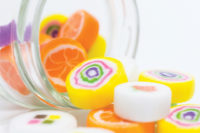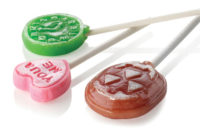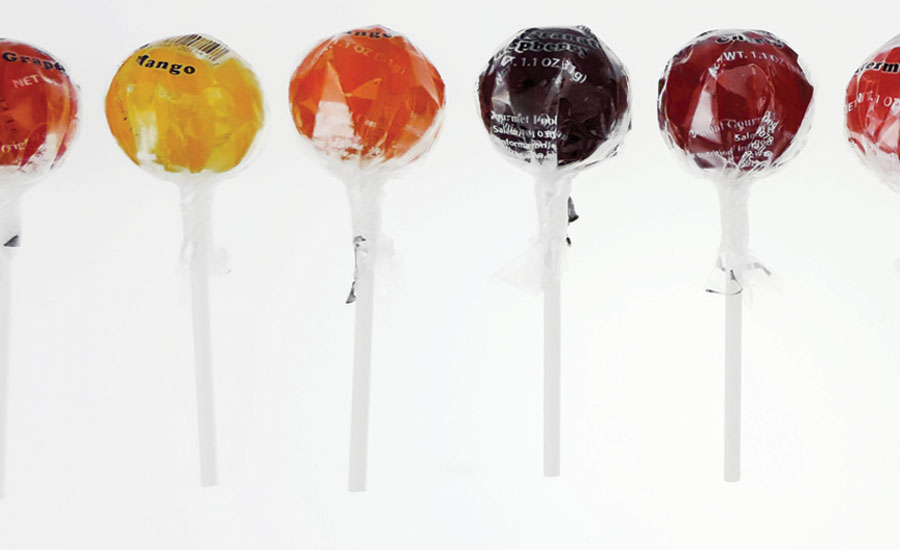2016 Lollipop and hard candy trends!
Wacky flavors, clever marketing, and a push toward functional lollipops help drive hard candy segment forward.














As far as we can tell, the lollipop and hard candy segment is pretty solid. As Jason Darling, owner of novelty lollipop company Lollyphile says, “It’s pretty great! So long as people are still orally fixated and have ‘sweet teeth’ we’re going to be going strong.”
Lollyphile has been around for eight years now, and demand has been pretty steady. But that hasn’t stopped candy makers from doing their homework and developing new flavors and flavor combinations to keep things exciting.
And, as with many other types of candy, lollipop-makers are looking for ways to develop “cleaner” pieces of candy.
“Better-for-you ingredients are now being asked for, such as tapioca syrup, rice syrup, evaporated cane juice, natural colors and flavors,” says Rick Griseto, v.p. of sales and marketing, Primrose Candy Co.
The biggest challenge, though, is not how much better-for-consumers the candy should be. It’s the cost of sugar, which is an understandably important ingredient in making lollipops. Staying competitive and profitable is not easy when there’s cheaper sugar elsewhere in the world.
“The goal is to keep this commodity type candy from going 100 percent to our off-shore competitors that have the ability to purchase world sugar, which at the moment can be purchased at half the cost of what U.S. manufactures can purchase it at,” says Griseto.
The competition is stiff, and candy makers know it. At the end of the day, there are only so many ways to combine sugar and flavoring to create new treats, which means standing apart with the end product is a real challenge.
To that end, Original Gourmet turns to packaging and marketing.
“Consumers are time-starved. If a decision or a purchase isn’t easily made, it may never be. They must quickly know ‘what’s in it’ for them,” says Angela LeBrun, marketing and quality assurance manager, Original Gourmet. “Accessibility, clear, understandable messaging and packaging are critical to encourage the consumer to reach for our products and bring them home.”
Original Gourmet’s clear wrappers let consumers see exactly what they shouldn’t pass up, especially in lollipops from their Sweetly Natural line. The growing line was inspired by consumer desire to eliminate artificial colors and flavors from their diets, as well as seek out products free from high fructose corn syrup (HFCS), partially hydrogenated oils, trans fats, and GMOs. Sweetly Natural lollipops check off all the better-for-you boxes – they’re GMO-free, HFCS-free, gluten-free, and peanut-free. They’re also naturally colored and flavored.
Original Gourmet knows it has a sweet product to offer. But it still has to stand out.
“Quality and affordability are key to making great candy accessible to everyone, but the digital marketing arena changes the game,” says LeBrun. “Social media allows brands to touch consumers, making emotions and memories together, making it relatable to everyday life. The brand becomes elevated with an ongoing relationship with consumers.”
Original Gourmet leverages different channels in different ways — all depending on the platform and the audience. For example, Facebook is great for dialogue with consumers and providing information, while Twitter and Instagram share fandom with followers who have a sweet spot for Original Gourmet treats, says LeBrun.
Of course, some lollipops are so out there that they basically speak for themselves.
Lollyphile builds its brand on the incredibly weird flavors it offers. Starting out with Absinthe and Maple Bacon lollipops, the company has since expanded its offerings to include outlandishly exotic flavors like Blue Cheese (“they’re really good,” says the caption on the website), Habanero Tequila (“hurts so good”), and Breast Milk (“the first flavor you ever loved”).
In Darling’s words, “I think we knock out the ‘office white elephant party’ demographic pretty well.”
But since Lollyphile tends to go for more odd flavors than most other companies, the biggest challenge is coming up with ones that are weird without being off-putting, he says. However, on the upside, having adventurous tastes comes with the added bonus of leading in flavor trends.
“We were the first company to make bacon (or maple bacon) hard candy, and the first to make Sriracha hard candy,” says Darling. “People watch us pretty closely.”
And Lollyphile is about to come out with what Darling calls “some serious Willy Wonka-level flavor combos.” Keep an eye out.
Flavors, though, aren’t the only area for innovation and growth.
Tom Morse is the father of Alina Morse, who founded Zollipops at nine years old with an eye for improving oral hygiene. He sees tremendous opportunity for growth and development in hard candy.
“Gums and mints have evolved and have become functional and deliver benefits such as fresh breath,” he says. “Candy has not taken advantage of this opportunity fully and positioned itself as functional and healthy.”
Amid growing concerns over sugar, candy has a chance to rebrand itself.
“Hard candy offers an ideal, if not superior, method of delivery to gums and mints, probably the most notable functional example is a cough drop,” says Morse.
That evolution hasn’t taken place in candy. He attributes this to a lack of innovation, leadership, marketing, and position. And therein lies both the opportunity and the challenge, he says.
Zollipops are made with Xylitol, Erythritol, Stevia and other “smile-friendly” natural ingredients. The lollipops help fight cavities by neutralizing acid, thereby raising the pH level inside the mouth and reducing bacteria.
The company has grown more 385 percent year over year. Retailers reported sales increases of 178.06 percent year over year. And online, sales were up 1200.1 percent in the first two months of 2016, Morse adds.
The company’s performance shows that consumers have an interest in good-for-you, free-from, and functional treats. The functional lollipops address a market need, and helps candy overcome consumer perception that confections are unhealthy.
“In a former life, as the co-founder and president of Living Essentials I created and launched 5-Hour Energy and helped establish the energy shot category. A dozen years ago, that category was less than $1 million, and today it is more than $1 billion,” says Morse. “We are applying that experience and leadership to Alina’s creativity and tenacity to help more kids and moms smile with Zollipops.”
Looking for a reprint of this article?
From high-res PDFs to custom plaques, order your copy today!













